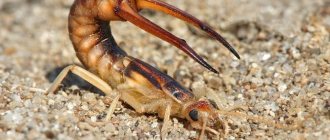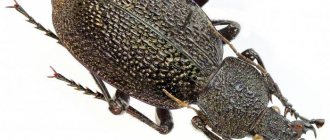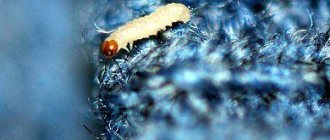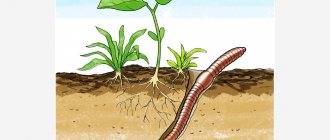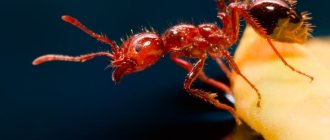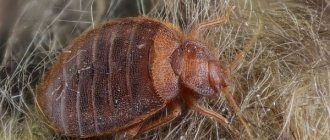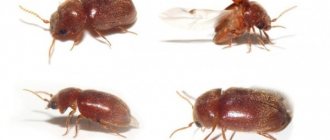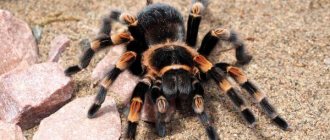Description of the double tail
Double-tailed
Two-tailed animals are small arthropods from the order of cryptomaxillary hexapods . Their ancestors lived millions of years ago. Two-tailed birds live in tropical climates; out of 800 species, about 30 are found in Russia.
The body length of most species is 2–7 mm . It consists of a head capsule and an abdomen, divided into 11 segments. At the end of the abdomen there are 2 appendages (cerci) . They can be long, thread-like or short, claw-like. Since two-tails do not have eyes, their functions are performed by the cerci.
The mouth is hidden in the head capsule. There are long antennae located in front of the head. On the initial segments of the abdomen there are 3 pairs of jointed limbs.
The body is bi-easted and light in color .
Due to their inconspicuous coloring, small size and hidden lifestyle, they are hardly noticeable. They live in moist soil and humus, in damp fallen leaves. Life expectancy is about a year.
Description of the earwig
Earwig
The earwig (mite or pincer) is an omnivorous insect pest from the order Leatherwing . It has an oblong and flattened body of medium size, up to 2–50 mm in length, covered with a durable chitinous shell.
The color of the insect is red or dark brown , the shade is lighter on the head and legs. The shape of the head is heart-shaped, sloping down. It is separated from the body by a square pronotum.
On the front of the insect's head there are long antennae, reaching 2/3 of the body in size. They consist of 11–14 segments. The eyes are small, it seems that they are completely absent.
The abdomen is segmented, at its end there is a pair of mandible appendages. In shape they can be thread-like or curved like pincers (forceps) . In males, unlike females, they are larger and jagged on the inside. Females have pincers that are shorter and almost straight.
If you touch an insect with your hand, it will arch the back of its body, put its claws forward and may bite . Because of this, the earwig is popularly called the pincer . The insect does not have poisonous glands; instead of poison, when in danger, a foul-smelling liquid is released.
Most earwig species have 2 pairs of wings . The front pair are short, leathery elytra of a dark brown or dirty yellow color, tightly fitting to the body. The hind legs are wide, membranous. Despite the presence of wings, the insect rarely flies. Because of their structure, the earwig rises vertically into the air, folding its membranous wings twice upon landing. They should fit completely under the front leathery elytra.
The insect moves mainly with the help of its legs . They are a running type of pest and are well developed.
The common earwig is widespread throughout the European part of Russia . In this species, males are larger than females - 17 mm in length. Females grow up to 14 mm. Less common is the coastal earwig .
In nature, it is found in sandy soil near water bodies.
Nutrition
As noted above, earwigs are omnivores. If we talk about eating animal food, then it would be more correct to call the earwig not a predator, but a scavenger. The diet includes spider mites, aphids, and various sedentary invertebrates. Earwigs destroy bee hives; they eat up to 300 milligrams of honey at a time. In addition, earwigs eat various plant parts, mosses, lichens and algae. Earwigs cause great damage to agriculture, eating the pulp of apples, peaches, pears, currants, cherries and cherries. It is difficult for them to gnaw through the hard skin of fruits, so they choose cracked fruits. In addition, earwigs leave their excrement on the fruits. In addition, they damage vegetables: zucchini, cucumbers, tomatoes, potatoes. Earwigs can inhabit barns and feed on tough grains.
Features of the life of earwigs
The insect loves warmth and moisture and often settles next to humans in rural areas. It is found in leaf litter, in compost heaps, under stones, fallen trees and near water bodies. Settles in residential buildings.
The insect is nocturnal - it hides in a shelter during the day, and crawls out at night in search of food. It is most active in cloudy, windy and rainy weather with minimal fluctuations in night and day air temperatures.
The pest reproduces in spring and early autumn . Mating lasts several hours. The male and female move back towards each other until their rear ends touch. After 2 months, the fertilized female lays white-yellow oval eggs in previously prepared burrows . She, alone or together with the male, makes a tunnel in the soil 5–15 cm deep with an expansion in the form of a chamber at the end.
It is there that the earwig lays 30–60 eggs in the fall and 20–30 in the spring. The female earwig is a caring mother; she remains near the eggs, rarely leaving the hole . Protects and turns eggs, providing the offspring with the most comfortable conditions. During this period, females are the most aggressive and bite the most painfully.
The earwig is an insect with an incomplete development cycle - from larvae it turns into an adult (imago) bypassing the pupal stage.
After spring mating, larvae appear 3 weeks later in May-June. They reach sexual maturity by the end of summer. During this time, the larvae molt 4 times. From eggs they emerge similar to adults, but smaller in size, gray-brown and without developed wings. With each molt, the insect's integument darkens and all parts of the body gradually form. Warm weather promotes rapid maturation of the insect.
During autumn fertilization, the eggs laid overwinter in the soil, and the adults crawl into burrows and hibernate.
The insect feeds variedly , eating living and rotting leaves and plant stems, the pulp of vegetables, fruits, bee bread and honey, pollen, lichens, and algae. From animal food it prefers the larvae of various insects, including pests: mites, aphids, caterpillars. Can eat bee larvae and the remains of large insects.
Common earwig (Forficula auricularia)
Appearance: the head is red-brown, the chest and paws are light brown, the abdomen and cerci are dark brown, almost black. Body length up to 3 cm.
Common earwig (two-tailed)
The distribution area is everywhere.
Classification (according to Wikipedia):
- Type: arthropod
- Class: insects
- Order: Leatherwings ( Dermaptera)
- Family: earworts ( Forficulidae)
- Genus: Forficula
- Species: Forficula auricularia
During the day it hides in dark, damp places, under the bark of trees, under objects lying on the ground. He loves various dirty rags, especially work gloves left in the garden (be careful, shake out earwigs before putting on gloves, especially if you suffer from insectophobia).
Earwigs begin breeding in late summer and early autumn.
To lay eggs, the female digs a hole about 10 cm deep, where she overwinters, covering the future offspring with her body and protecting them from possible attacks by other insects, including their relatives and their own male.
The male spends the winter with the female, but usually does not survive until spring. In the spring, the female lays another clutch of eggs. After waiting for the larvae to emerge (after 5-6 weeks), it continues to protect the offspring for some time, then completes its life cycle, and the larvae (nymphs) begin an independent life. In appearance, the larvae differ slightly from adult insects.
Common earwig (two-tailed)
Due to their food preferences, the earwig is a pest, however, in my memory, there was no noticeable damage from them. As usual, it all depends on the number and crowding.
It is also known that earwigs can climb into bee hives, where they live quietly in insulating material and various crevices, feeding on honey, beebread and even bees (according to Wikipedia). The latter gives me vague doubts; somehow I can’t believe that an earwig can cope with a bee. Rather, we are talking about bee larvae.
Why is an earwig dangerous?
The earwig is omnivorous. It gnaws out all parts of plants: leaves, flowers, berries, fruits, roots, unripe seeds and young shoots . First it leaves holes, then it completely destroys the leaves and damages the stems.
The pest is dangerous both in open ground and in greenhouses. The insect damages cereal plants, corn, cabbage, cucumbers, melons, pumpkin, legumes, beets, celery, tomatoes, and potatoes.
On fruit trees, the earwig looks for fruits that are overripe, weak, or already damaged by other insects and birds. Willingly eats peaches, apples, pears, cherries, plums, and cherries.
It deprives many flower crops of their decorative value: chrysanthemums, roses, carnations, dahlias, asters, phlox, poppies.
The pest can settle in beehives, houses and non-residential buildings . He opens honeycombs and loves to feast on honey . It is found in clothes and underwear, makes its way to food, and can crawl into bread and the refrigerator.
In addition to plant foods, it eats animal foods. Prefers other insect pests with soft covers. It is impossible to determine how much such benefit outweighs the harmful activity.
Earwig food - our plants
These animals are omnivores and are not averse to eating vegetables, fruits, berries and flowers in your garden plot, and sometimes on your own table, eating up the leftover food. Therefore, you should take the order on the table and cleaning up after meals very seriously. If you are a lover of ornamental plants, then you have probably often encountered the problem of the death of roses, chrysanthemums, carnations, dahlias and other flowers. The reason for this may be the aforementioned insect pests. The earwig is a burden for the gardener, gnawing everything in its path: leaves, shoots of young plants, flower petals.
How to get rid of earwigs in your home and yard
Chemical and biological drugs
Karate
The contents of the 1 ml ampoule are first diluted in 1 liter of water, then the volume of liquid is adjusted to 10 liters. The product is used in calm weather at an air temperature not higher than 35°C and humidity up to 65%.
Inta-vir
Insecticide of enteric contact action without a pungent odor. Quickly affects the nervous system of the pest. The protective effect lasts 10–15 days.
To spray leaves, 1 tablet of the drug is dissolved in 10 liters of water. For treating indoor plants, the consumption rate is 1 g per 1 liter of water.
Spark
Active, odorless insecticide for spraying plants in the garden, vegetable garden, greenhouse and home. Consumption rate: 1 tablet per 10 liters of water. First, the drug is diluted in 1 liter of warm water at a temperature of 35–40°C. Then the working solution is diluted with the remaining water. Fruit and berry plants cannot be processed during flowering and fruiting. The pest control drug is used before budding or after harvesting.
For indoor prevention, use the insecticide Iskra golden in the form of sticks. Depending on the diameter, one pot will require from 1 to 6 pieces. If the pests have already appeared, then a solution of 1 ml of product and 2 liters of water is prepared for spraying.
Iskra BIO is used for greenhouse plants . This emulsion is effective in hot weather at air temperatures above 28°C. 2 ml of the drug are diluted in 1 liter of water.
Dichlorvos
A broad-spectrum intestinal pesticide, the death of the pest after treatment is 95–100%. Before use, the can of the drug is shaken and sprayed in insect habitats.
If the treatment takes place in a room, then the windows and doors are closed, and after the procedure is completed, the room must be ventilated 2 hours later. When spraying, there should be no food, animals, or children nearby.
Raptor
Universal insecticide in aerosol form. Before treatment, shake the can and spray areas where insects accumulate for 6–8 seconds. The drug is convenient to use in hard-to-reach places: behind cabinets, in narrow wall openings.
Fufanon
The active substance of the drug settles not only on the leaves and shoots of plants, but also spreads in the air, enhancing the effect due to fumigation. The insecticide does not change the taste and smell of the fruit. Consumption of product for treating vegetable and fruit crops: 5 ml per 5 liters of water, for ornamental plants in the garden and in the house - 1 ml per 1 liter of water. The protective effect lasts 5–10 days.
In the house, as well as in the area where insects accumulate, they are treated with any insecticide. In the fight, you can use chalk "Mashenka" from cockroaches . Having determined the habitat of earwigs, mark this area with chalk: corners, baseboards, ventilation holes.
Traditional methods
- A solution is prepared from garlic to kill the pest. 200 g of cloves are poured with vegetable oil for a day. Then the concentrate is filtered and 2 tbsp is used to spray the plants. l per 1 liter of water. For greater adhesion, laundry or liquid soap is added to the solution.
- Insects do not like the smell of vinegar, onions, wormwood, tansy, and mint. You can repel them by soaking rags in substances that are unpleasant to the pest. In the house, corners, floors and baseboards of rooms are sprayed with these infusions.
- Bait is prepared from boric acid. 1 boiled egg yolk and 50 g of boric acid are mixed, rolled into balls and placed where the earwig was noticed.
- Set up a simple earwig trap by filling an empty jam jar or flower pot with straw or scraps of paper. Stick a pole into the soil and place the jar or pot upside down among the tops of the plants. Adult earwigs will not resist the temptation to take refuge in this shelter for the night. In the morning, before they become active again, shake them out of the trap away from your plants or near aphid-infested plantings.
- In the house, earwigs are caught by placing wet rags and sponges in the bathroom and kitchen overnight. The collected insects are taken away from the house and destroyed.
- In the garden and vegetable garden, when digging the soil, a cluster of insects is poured with boiling water.
Ridding the house of pests
Getting rid of pests
In private houses, earwigs are found much more often than in apartments. After all, it’s easy for pests to enter a house from the garden. In addition, private buildings have more damp rooms.
- Before you start fighting earwigs in a private home, you need to get rid of existing debris and dry damp rooms, checking all drainpipes for leaks.
- You should not ignore indoor plants growing in the house, because insects often live in their excessively moist soil.
- To get rid of earwigs in an apartment or house, it is necessary to limit the paths of their entry by sealing all cracks and crevices, as well as using mosquito nets on the windows.
- You can find an effective remedy for earwigs at the sanitary and epidemiological station. Usually, ready-made poison is used or in the form of baits based on yolk and bran.
- Boric acid will also help quickly get rid of pests in the house. It can be scattered on the floor or formed into balls by mixing with egg yolk. The use of this method requires limiting the access of insects to water. Otherwise, it will not be possible to achieve a positive result.
- You can also poison the nippers using the famous Mashenka chalk. They rub it on all baseboards in a house or apartment, and also apply the product in places where insects appear.
Earwig bite. What to do?
The earwig bites humans with its claws only for the purpose of self-defense if it is accidentally stepped on or picked up. The bite is painful, the damaged area itches and swells . In case of danger, instead of poison, a brown, foul-smelling liquid is released .
With a deep puncture, a small wound is formed and blood flows. The bite site should not be scratched; it should be washed with soap and water and wiped with an antiseptic .
It is a common belief that earwigs often crawl into the ear of a sleeping person . Such cases are rare. If this happens, then a few drops of hydrogen peroxide or vegetable oil are placed in the ear so that the insect crawls out. If you cannot get rid of the earwig, then go to the hospital.



